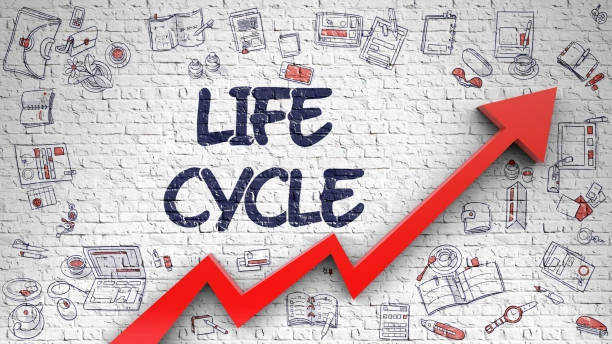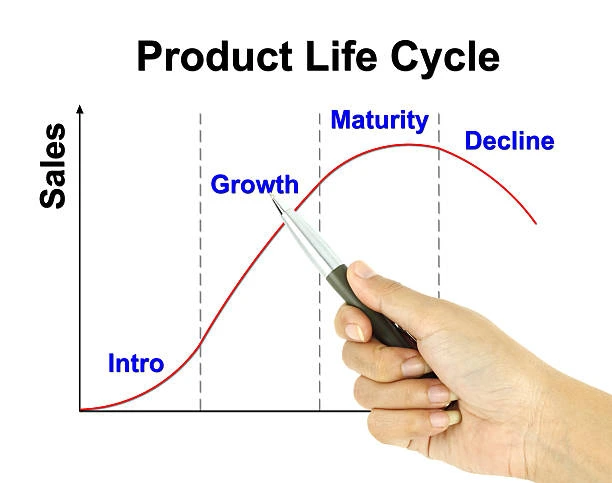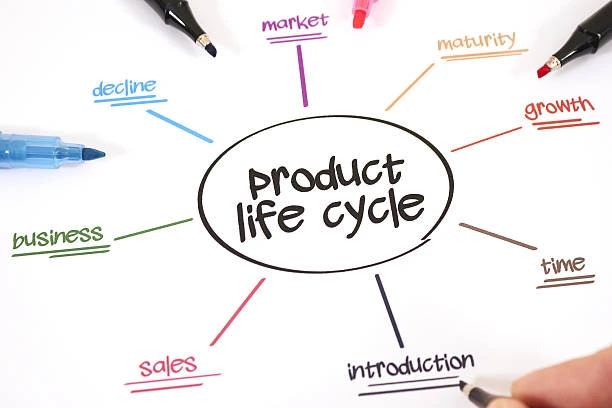
Introduction: Marketing Strategy In Product Life Cycle
The concept of a product life cycle has occupied a prominent place in the marketing literature, both as forecasting tool and a guideline for corporate marketing strategy. Lets see some effective Marketing Strategy in Product Life Cycle
What is Product and Product Life?
Basically, a product is the object of the exchange process, the thing which the producer or supplier offers at a potential customer in exchange for something which the supplier thinks as equivalent or of greater value. The product is an important component of the marketing mix. A product is anything that can be offered to a market to satisfy a want or need. It includes goods, services, experiences, events, persons, place, properties, organizations, information and ideas.
Product Life:
The definition of product life is context dependent as well as user-dependent, E.g., for a customer the product life is the period of time that she/he uses it(e.g. from purchasing until it is disposed of). In contrast to this, the product life is normally longer for the producing compony; it starts with the ideas of a product and concludes with the end of the production with the end of the service period for the product.
The Product Life Cycle (PLC)

The product life cycle is the period of time over which an item is developed, brought to market and eventually removed from the market. It is an important tool for analysis and planning of the marketing mix activity.
Must Read: THE ROLE OF MARKETING IN STRATEGIC PLANNING
The product life cycle is the concept that a product goes through several stages in the course of its life:
1. Product development stage.
2. Product introduction stage.
3. Product growth stage.
4. Product maturity stage.
5. Product decline stage.
1.Development stage:
The development stage of the product life cycle occurs when a corporation finds and develops a new product idea. A product is generally undergoing several changes involving a lot of money and time during development, before it is exposed to target customers via test market. At this stage, sales are zero and revenues are negative.
2. Introduction stage:
The introduction stage of the product life cycle occurs when a product is first introduced to its target market. Large expenditure on promotion and advertising is common. A corporation must be prepared to spend a lot of money and get only a small proportion of that back. At this stage, sales are low, production costs tend to be high and profit is negative or very low.
3. Growth stage:
The growth stage of the product life cycle occurs when demand for the new product starts increasing rapidly. This is the right time to focus on increasing the market share because innovators move from the trial to repeat purchase if they are satisfied with the product though innovators may influence others by word of-mouth, which is often considered the most effective mode of communication. A new growing market alerts the competition’s attention. At this stage, sales are rise, revenues increase and profit rise.
4. Maturity stage:
The maturity stage of the product life cycle occurs when demands have reached its planned or unplanned peak, and the percentage that it’s ever going to buy the product has been reached. This stage of life cycle is the longest phase for most products. Competition is most intense during this stage. At this stage, sales reach peak, and market share may be high.
5. Decline stage:
The decline stage of product life cycle occurs when sales continue a strong downward drift and profits erode rapidly toward the zero point. The typical reason for a product decline is the entry of new products coupled with decreases consumer interest in specific product.
Must Read: 8 STRATEGIES OF RETAIL MARKETING TO DRIVE SALES
5 Best Marketing Strategy in Product Life Cycle

1.Advertising
In the introductory stage, advertising informs customers about the existence, advantages, and uses of new products. During the growth stage, advertising stresses the merits of the products compared to competing products. In the maturity phase, advertising attempts to create impression of product differentiation. And in the decline stage, the percentage of sales going into advertising decrease.
2. Product changes
Changes in the features, performance, design, and so for the of a product were explored by Schewing (1974), who suggested the following product changes at each stage of the product life cycle
- Introduction of new product;
- Growth-product modification;
- Maturity- product modification and differentiating;
- Saturation- product modification, differentiating, and diversification; and
- Decline- product diversification.
3. Distribution
Initial distribution is believed to be selecting and learn, and to reach its full coverage at the growth stage, when retail outlets are seeking the product. At the maturity stage, retail outlets are the first to suffer from changes in consumer purchase patterns, hence a producer may start losing outlets. At the same time, efforts are made by manufactures to establish new methods of distribution and new outlets.
4. Pricing
Price we usually believed to be high at the introductory period and to decline with the product life cycle stages as price becomes an increasingly important completive weapon, especially at the late stages of growth and throughout the maturity and decline. In determining the product’s price strategy, not only the introductory price should be considered, but also what the next move might be, being alternative competitive actions.
5. Life extension
When a company develops a new product or service, it should try to plan at the very outset a series of actions to be employed at various subsequent stages in the product’s existence so that its sales and profit curve are constantly sustained rather than following their usual declining slope.
Stage wise Marketing Strategy in Product Life Cycle
Marketing Strategy in Product Life Cycle for Introduction Stage
During the introduction stage, company’s objectives should be to establish a transparent complete identity connect with the proper partners to market his product set up shopper tests, or offer samples or trials to key target markets price the product or service as high as they will be able to sell it, and to replicate the standard level you’re providing
- Rapid skimming – launching the product at a high value and high promotional level slow
- Skimming – launching the merchandise at a high value and low promotional level
- Rapid penetration – launching the merchandise at an occasional value with important promotion
- Slow penetration – launching the merchandise at an occasional value and token promotion
Marketing Strategy in Product Life Cycle for Growth Stage
Strategies employed in the growth stage mainly aim to extend profits.
- A number of the common methods to do are:
- Improving product quality
- Adding new product options or support services to grow your market share
- Enter new markets segments
- Keep valuation as high as is cheap to stay demand and profits high
- Increase distribution channels to address growing demand
- Shifting selling messages from product awareness to product preference
- Skimming product costs if your profits square measure too low.
Marketing Strategy in Product Life Cycle for Maturity Stage
When sales is on peak, the product can enter the maturity stage. This usually means that market are saturated and you will realize that you just ought to modification your selling techniques to prolong the life cycle of your product. Common methods which will facilitate throughout this stage fall into one amongst two categories:
Market modification – this includes getting into new market segments, redefining target markets, winning over competitor’s customers, changing non-users
Product modification – as an example, adjusting or rising your product’s options, quality, valuation and differentiating it from alternative merchandise within the marking
Marketing Strategy in Product Life Cycle for Decline Stage
During the last stages of product life cycle, company will see declining sales and profits. this could be caused by changes in shopper preferences, technological advances and alternatives on the market. At this stage, company will decide to:
- Reduce promotional expenditure on the product
- Reduce the amount of distribution shops that sell them
- Implement value cuts to urge the purchasers to shop for the merchandise
- Find another use for the product
- Maintain the product sales and look ahead to competitors to withdraw from the market First
- Harvest the product or service before discontinuing it.
Other Effective Marketing Strategy in Product Life Cycle
- Promoting more frequent use of the product among current users.
- Developing more diverse use of the product among current users.
- Creating new users for the product by expanding the market.
- Finding new users for the basic material.
Marketing Strategy In Product Life Cycle FAQ
What are the marketing strategies based on product life cycle?
Advertising, Product changes, Distribution, Pricing,Life extension
What are the 5 stages of product life cycle in marketing?
The product life cycle is the concept that a product goes through several stages in the course of its life:
- Product development stage.
- Product introduction stage.
- Product growth stage.
- Product maturity stage.
- Product decline stage.
What is product life cycle explain?
The product life cycle is the period of time over which an item is developed, brought to market and eventually removed from the market. It is an important tool for analysis and planning of the marketing mix activity.
Why is product life cycle important?
The product life cycle is important in marketing because it helps define and determine strategies related to a particular product.
LIKE WHAT YOU’RE READING?
CHECK OUT SOME OF OUR OTHER GREAT CONTENT HERE:
- MARKETING MANAGER ROLES AND RESPONSIBILITIES
- DEFINITION OF B2C MARKETING WITH EXAMPLE
- CONTENT MARKETING STRATEGIES FOR SMALL BUSINESSES
- DEFINITION OF MARKETING MANAGEMENT
- ROLE OF BLOGS IN MARKETING
- UNDERSTANDING DIGITAL MARKETING
- WHAT IS AFFILIATE MARKETING? (HOW TO GET STARTED)
- PERFORMANCE MARKETING – A BEGINNER’S GUIDE
- EFFECTIVE BRANDING METHODS
- UNDERSTANDING CONSUMER BEHAVIOR
- HOW TO INCREASE SALES?
- HOW AI IS USED IN DIGITAL MARKETING?
- 5 BEST SOCIAL MEDIA PLATFORMS FOR BUSINESS IN 2022
- WHAT IS THE DEFINITION OF ECOMMERCE
- ROLE OF SOCIAL MEDIA IN MARKETING
- WHAT IS ZERO-BASED BUDGETING
- DECODING DIRECT MARKETING WITH EXAMPLES
- 5 BEST TOOLS FOR DIRECT MARKETING WITH ADVANTAGES IN DETAIL
- WHAT IS A MARKETING RESEARCH?
- 6 STEPS OF COMPETITION ANALYSIS IN MARKETING



How Are You
Thanks a bunch for sharing this with all folks you actually recognize what you’re talking about! Bookmarked. Kindly additionally consult with my web site =). We can have a link change contract among us
https://cutt.ly/82gSTpT
adcardz.com/moneytraffic
Best Regards